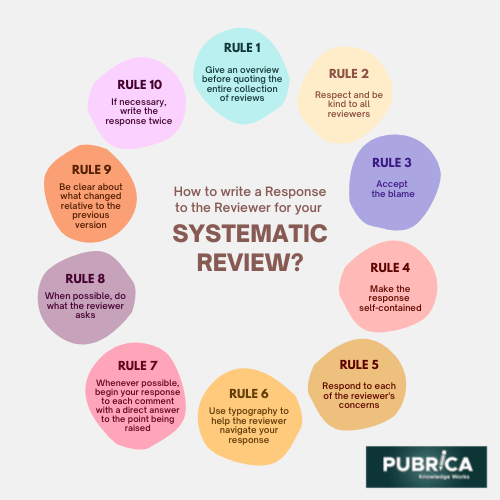
The use of network meta-analysis in the field of physical exercise and health promotion
June 14, 2022
How to Conduct a Systematic Review for Prospective Studies?
July 28, 2022In brief
The reviewing process, in theory, may considerably enhance work by allowing many experts in the subject to provide input. Indeed, actual data shows that articles that have gone through numerous rounds of peer review perform better in terms of citation counts than those approved immediately. In practice, the review process may be emotionally draining as you deal with comments that appear ill-informed, prejudiced, or otherwise problematic. This blog aims to respond to reviewers for the systematic review and the peer review. Scientists’ training programs normally contain courses on how to write a scientific and systematic review, but they seldom address how to cope with reviewer concerns.
Introduction
A well-written “answer to reviewers” document is an important component of your response. This document, which summarizes the adjustments you made in response to the critiques, is submitted with your amended systematic review. Authors sometimes spend too much time rewriting the systematic review and not enough time making the response paper clear and persuasive. As a result, there may be miscommunication between reviewers and authors, leading to the rejection of a high-quality systematic review. The 10 basic guidelines listed below might assist you in creating a successful response to reviewers.

Rule 1: Give an overview before quoting the entire collection of reviews.
The response letter will usually start with a summary of modifications, highlighting new data and analyses undertaken in response to all of the reviewers’ most important points. Note that the response may, at your choice, include figures and tables for the reviewers’ use but will not be included in the Conducting A Systematic Review or supplement. You might mention these extra findings in your introduction. If several reviewers express a criticism, it might also be mentioned in the summary. The response letter should include the reviews intermingled with your replies.
Rule 2: Respect and be kind to all reviewers.
Even if you are persuaded that the reviewer lacks intellectual aptitude, conveying this impression to the reviewer is not in your best interests. Remember that if the reviewer doesn’t understand something, it’s certainly your fault for not making the point plain enough. If the reviewer does not appear to be an expert in the field, keep in mind that their level of knowledge (or lack thereof) may reflect many journal readers. Your objective is to make the job understandable to everyone, not just specialists.
Rule 3: Accept the blame
Suppose something was unclear to the reviewer, apologies for not making it obvious. Consider changing the text and quoting the updated text in your answer, even if you are confident that the wording is already obvious (i.e., the reviewer missed it). In general, even if the suggested adjustment appears to be superfluous, editing is typically preferable to demonstrate to the reviewer that they were heard and understood.
Rule 4: Make the response self-contained
When you make modifications to the text or figures, include a direct reference to the changes in your answer. If feasible, point to the particular line number where the improvements were made, but mention whether you’re referring to the original or altered systematic review line numbers. Without switching back and forth between your systematic review and the answer, a self-contained response letter allows the reviewer Systematic Review Service to comprehend exactly what you accomplished.
Rule 5: Respond to each of the reviewer’s concerns.
Reviewers frequently complain that the writers neglected to reply to various concerns stated in the review. The reviewer may disagree with your response in some situations, but you should not try to avoid a difficult question by disregarding it. Reviews are frequently arranged into bullet points; however, a reviewer may mention two unrelated concerns inside a single bullet. Make sure to react to both critiques explicitly in such cases.
Rule 6: Use typography to help the reviewer navigate your response
Change the typeface, colour, and indenting to distinguish three elements: the systematic review, your comments on the study, and your adjustments to the systematic review. In the opening of your response, you can clarify these typographical norms.
Rule 7: Whenever possible, begin your response to each comment with a direct answer to the point being raised
You can give background information, but only after you’ve given your main response. When feasible, respond with a “yes” or “no.” Declare that the reviewer is accurate in your response. You aim to demonstrate to the reviewer that you paid attention to their concerns, and you should promptly communicate what you did in response to their criticism.
Rule 8: When possible, do what the reviewer asks
Don’t assume that you couldn’t care less about carrying out the additional tests or analyses that the reviewer requests. Even if you believe the reviewer has asked for an analysis that you don’t find informative or is otherwise flawed, you’ll often be in a stronger position if you follow the reviewer’s instructions, report the results in your response, and then explain why the results don’t belong in your Clinical Trial Systematic Review Services.
Rule 9: Be clear about what changed relative to the previous version
When you modify in response to a reviewer’s feedback, it might be difficult to communicate exactly what that change entails to the reviewer. When responding to a reviewer’s criticism, an author frequently makes the mistake of replying, “This point is handled throughout the manuscript in the following way…” This response is unclear as to whether the author is merely pointing out language in the prior version of the manuscript or whether the author is outlining changes made to the current edition.
Rule 10: If necessary, write the response twice
In your first draft of the “answer to reviewers” document, you may try to figure out what the reviewer was getting at while thinking about possible ways to respond and the cost-benefit tradeoff of running more tests. This document can assist you and your coauthors decide how to construct a final response document. The first document can also express your dissatisfaction with evaluations that you believe are unfair or disrespectful. After you’ve finished writing this first draft, you may go on to create a separate document that contains the information you want the reviewers to Write a Systematic Review
Conclusion
One of the most difficult aspects of the publication process is responding to reviewer critiques. It’s important to recollect that, in most situations, the reviewers are well-intentioned colleagues who offer their time to ensure the validity of results presented in the scientific literature. In almost every case, the document from the review process is better than the original.
About Pubrica
Pubrica’s team of researchers and authors produce scientific and medical research papers that may be a helpful resource for practitioners and authors. Pubrica medical writers may help you create and modify the introduction by pointing out any errors or limitations in the chosen research field to the reader. Our experts are familiar with the framework that follows the broad topic, problem, and background before moving on to a more specialized topic to develop the hypothesis.
References
- Noble, William Stafford. “Ten simple rules for writing a response to reviewers.” PLoS computational biology 13.10 (2017): e1005730.
- Hiemstra, Pieter S. “How to write a response to the reviewers of your manuscript.” Breathe 14.4 (2018): 319-321.
